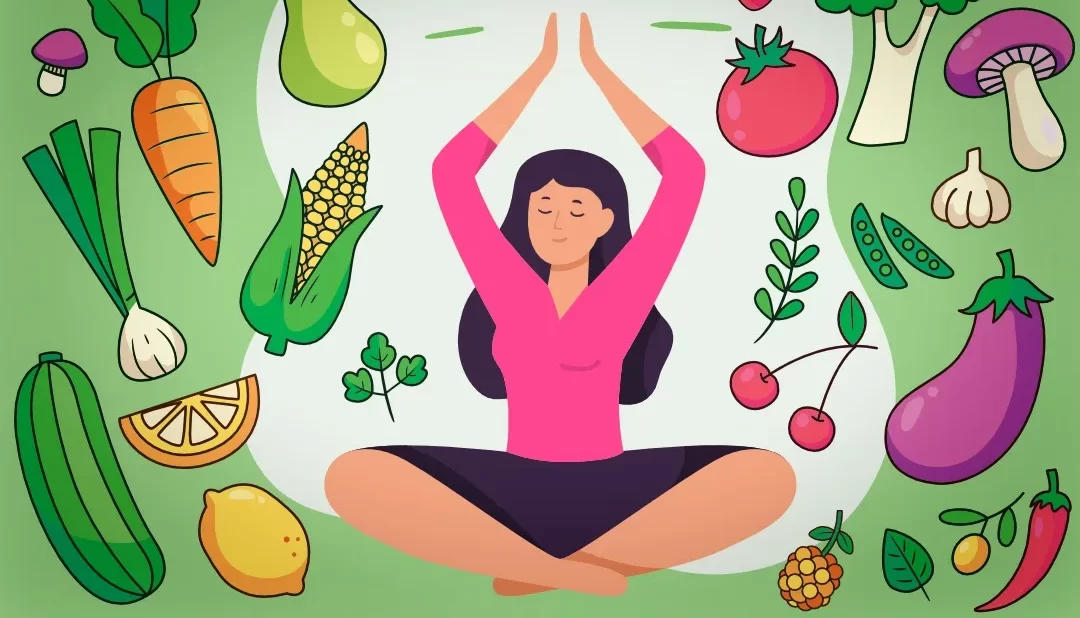Given that the Sattvic diet has roots in Ayurveda, a medical system that originated in India over 5,000 years ago, many individuals who do yoga favor it. The Sattvic diet may have a lot of health benefits because its adherents mostly eat wholesome foods like fresh produce and almonds. It is rather limiting, though, and many nutritious foods are forbidden.
What exactly is the Sattvic diet?
Many yoga practitioners adhere to the Sattvic diet, which is a vegetarian diet high in fiber and low in fat. Three food categories—sattvic, rajasic, and tamasic—have different attributes and health implications in the yoga practice.
The term “sattvic” refers to “pure essence,” and foods considered to be sattvic are regarded to be pure and balanced, promoting feelings of serenity, joy, and mental clarity. Meals that are tamasic are said to promote weakness and laziness, while meals that are rajasic are described as too stimulating.

Sattvic foods are seen to be the healthiest of the three, and Sattvic diets are linked to high intakes of micronutrients. The Sattvic diet is recommended by Ayurveda as the finest option for enhancing longevity, physical fitness, and mental health.
This may be due to the fact that sattvic diets are high in nutrient-dense, fresh foods including fruits, vegetables, sprouted whole grains, fresh fruit juices, legumes, nuts, seeds, and herbal teas. According to Ayurveda, rajasic and tamasic foods should be avoided and sattvic foods should be consumed primarily.
When consuming a Sattvic diet, items like animal proteins, fried foods, white sugar, and stimulants like coffee are prohibited.
The Sattvic diet is for whom?
For those who are committed to adhering to Ayurvedic principles, the Sattvic diet may be a wise choice. Compared to more permissive plant-based eating patterns like pescatarian, lacto-ovo vegetarian (a diet that allows eggs and dairy but is otherwise vegetarian), and whole-foods plant-based (WFPB) diets, it is a more complex plant-based diet that excludes more foods.
People who follow the Sattvic diet avoid consuming a lot of animal-based items including meat, fish, eggs, and poultry. Because it is founded on Ayurvedic principles. The diet excludes a few plant-based foods as well, such as garlic and onion. These foods made from both plants and animals all contain vital nutrients.
Anyone can follow the Sattvic diet, despite the fact that Ayurvedic practitioners tend to favor it the most. However, people who want to gain and maintain the health benefits of plant-based diets might find that less stringent eating plans are a better option. The nutritional requirements of those who are pregnant or nursing may not also be met by this diet.
Food items to look for

You must consume only things that are allowed on the Sattvic diet and stay away from rajasic and tamasic meals. Always remember that suggestions for which foods are sattvic differ depending on the source. And Many sources contradict one another over which foods are appropriate.
The Sattvic diet allows for the liberal consumption of the following items:
- Vegetables from both the land and the sea, such as spinach, carrots, celery, potatoes, broccoli, kelp, lettuce, peas, and cauliflower.
- Fruits and fruit juices: guava, papaya, mangos, cherries, melons, peaches, apples, bananas, papaya, papaya, papaya, and fresh fruit juices, for example.
- Sprouted grains include millet, quinoa, wild rice, amaranth, bulgur, and barley.
- Nuts, seeds, and coconut products, such as flaxseed, unsweetened coconut, Brazil nuts, pumpkin seeds, sunflower seeds, and sesame seeds.
- Olive oil, sesame oil, red palm oil, flax oil, ghee, and other fats and oils.
- Dairy goods and nondairy substitutes. It includes premium milk, yogurt, and cheese made from nuts and seeds and milk from pasture-raised animals.
- Lentils, mung beans, chickpeas, bean sprouts, tofu, etc. are examples of legumes and bean products.
- Drinks include water, fruit juice, and herbal tea without caffeine.
Coriander, basil, nutmeg, cumin, fenugreek, turmeric, ginger, and other sattvic spices and herbs. - Honey and raw cane sugar or jaggery are sweeteners.
Remember that dairy products offer more protein, vitamin A, and vitamin D than substitutes when deciding between them and nondairy options.
When following the Sattvic diet, the aforementioned foods should comprise the majority of your diet. Remember that there are diets with tougher and lighter restrictions.












Be First to Comment